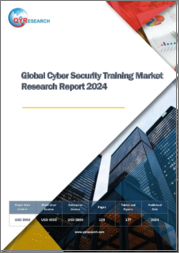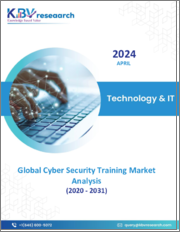
|
시장보고서
상품코드
1518773
세계의 사이버 보안 트레이닝 시장(2024-2031년)Global Cyber Security Training Market 2024-2031 |
||||||
세계 사이버 보안 트레이닝 시장 규모는 예측 기간(2024-2031년) 동안 연평균 16.8%의 연평균 복합 성장률(CAGR)로 성장할 것으로 예상됩니다. 세계 사이버 보안 트레이닝 시장은 사이버 위협 증가, 규제 준수 요구 사항, 디지털 기술 채택 증가, 사이버 보안 기술 부족, 기술 발전, 원격 근무 인력 보안, 내부자 위협에 대한 관심 증가, 사이버 보안 인식 향상 교육의 노력으로 성장하고 있습니다. 멀웨어, 피싱 공격, 랜섬웨어, 데이터 유출과 같은 사이버 위협의 급증으로 직원들에게 효과적인 교육이 필요하며, GDPR(EU 개인정보보호규정)(EU 개인정보보호규정), HIPAA, PCI DSS와 같은 규정 준수는 사이버 보안 트레이닝 솔루션에 대한 수요를 촉진하고 있습니다. 수요를 촉진하고 있습니다. 디지털 기술, 클라우드 컴퓨팅, IoT, 원격 근무에 대한 의존도가 높아지면서 사이버 위협의 공격 대상이 확대되고 있습니다. 교육 프로그램은 AI, 머신러닝, 블록체인과 같은 새로운 기술을 다루며 진화하는 위협에 대응할 수 있도록 돕습니다.
시장 역학
이머징 마켓의 디지털 기술 도입 증가
신흥국의 디지털 기술 도입이 가속화됨에 따라 소비자들에게 위험 감소, 데이터 보호, 안전한 온라인 탐색에 대한 교육을 위한 사이버 보안 트레이닝이 요구되고 있습니다. 미국 국제개발처(.gov)에 따르면, 2023년까지 전 세계 약 26억 명이 인터넷에 접속할 수 없어 인터넷 연결과 디지털 금융 인프라에 대한 투자가 시급한 상황이며, USAID의 디지털 인베스트(Digital Invest)는 40개국에 걸쳐 다양한 기술 기업들과 파트너십을 맺어 프로그램을 확장하고 있습니다. 40개국에 걸쳐 다양한 기술 기업들과 파트너십을 맺음으로써 신흥국 시장에서 개방적이고 종합적이며 안전한 디지털 생태계를 구축하는 데 큰 진전을 이루었습니다.
사이버 보험의 확산
정보 유출로 인한 비용 증가로 인해 사이버 보험의 인기가 높아지고 있으며, 조직은 사이버 보안 트레이닝을 통해 보안 조치에 대한 헌신을 보여줌으로써 보험 가입 자격을 얻을 수 있습니다. 230만 달러로 사상 최고치를 기록했으며, 2020년 이후 28.0%의 큰 폭으로 증가했습니다. 탐지 및 에스컬레이션 비용은 45.0%로 크게 증가하여 보다 복잡한 침해 조사로 전환되고 있음을 보여줍니다. 피싱 공격은 인도 내 정보 유출의 약 22.0%를 차지했으며, 인증정보 도난 및 유출이 16.0%로 그 뒤를 이었습니다. 소셜 엔지니어링은 가장 비용이 많이 드는 침해의 근본 원인으로 확인되었으며, 그 재정적 영향은 2억 4,000만 달러, 악의적인 내부자 위협은 약 2억 4,000만 달러로 나타났습니다. 전 세계적으로 데이터 침해에 대응하는 방식에 있어 조직은 두 갈래로 나뉘었으며, 침해 사고를 당한 조직의 57.0%는 사고 비용을 소비자에게 전가하고, 51.0%는 보안 투자를 늘리기로 했습니다.
시장 세분화
- 유형별로 보면, 시장은 온라인 교육, 강의실 교육, 부트캠프로 나뉩니다.
- 제공 방식에 따라 자습형 교육, 강사 주도형 교육, 혼합형 교육으로 구분됩니다.
- 교육 내용별로는 사이버 보안 기초 교육, 기술 기술 교육, 컴플라이언스 교육, 신기술 교육, 사이버 보안 리더십, 기타(침해사고 대응 교육, 모바일 보안 교육)로 구분된다, 모바일 보안 교육)으로 구분됩니다.
- 인증에 따라 시장은 벤더별 인증과 업계 표준 인증으로 나뉩니다.
- 대상자별로 시장은 기업과 개인으로 구분됩니다.
- 최종 사용자별로는 BFSI, IT/통신, 헬스케어, 정부/국방, 제조, 에너지, 기타(교육 분야, 법률/전문 서비스)로 구분됩니다.
BFSI가 가장 큰 부문이 될 것으로 전망
BFSI 부문이 시장에서 가장 큰 비중을 차지할 것으로 예상됩니다. 이 부문의 성장을 뒷받침하는 주요 요인으로는 사이버 보안 트레이닝 서비스에 대한 수요 증가를 들 수 있습니다. 디지털 경제 성장을 주도하는 디지털 결제에 따르면, 2023년 인도 디지털 생태계의 성장은 디지털 인디아, 메이크 인디아, 스타트업 인디아 등의 정부 이니셔티브가 헬스케어, 교육, 농업 등의 분야에서 디지털 기술을 촉진할 것으로 예상됩니다. 을 추진하고 있습니다. 인터넷과 스마트폰의 보급도 이러한 성장에 기여하고 있습니다. 인터넷 사용자 수는 2023년까지 8억 명, 모바일 지갑 사용자 수는 2025년까지 9억 명에 달할 것으로 예상됩니다.
시장 세분화가 큰 점유율을 차지합니다.
이 플랫폼은 사이버 보안 전문 인력에 대한 수요가 증가함에 따라 사이버 공격을 효과적으로 제거할 수 있는 고도의 교육을 제공합니다. 예를 들어, 2021년 4월 Sparkle은 실시간 공격 시뮬레이션을 통해 기업의 사이버 보안 역량을 강화하기 위한 머니즈드 사이버 보안 트레이닝 플랫폼을 출시했습니다. 이 플랫폼은 스파클이 기업용 디지털 시장의 선두주자로 자리매김하는 것을 목표로 하고 있습니다.
지역별 전망
세계 사이버 보안 트레이닝 시장은 북미(미국, 캐나다), 유럽(영국, 이탈리아, 스페인, 독일, 프랑스, 기타 유럽), 아시아태평양(인도, 중국, 일본, 한국, 기타 아시아태평양), 기타 지역(중동 및 아프리카, 라틴아메리카) 등 지역별로 세분화되어 있습니다. 더 세분화되어 있습니다.
아시아태평양의 사이버 보안 위협 환경 확대
세계 사이버 공격 증가, 특히 인도와 아시아태평양의 사이버 공격 증가는 조직이 진화하는 위협을 효과적으로 탐지, 예방 및 대응하기 위해 사이버 보안 트레이닝에 투자해야 할 필요성을 강조하고 있습니다. 2023년 5월 이코노믹 타임즈에 따르면, 인도에서는 2023년 1분기에 사이버 공격이 크게 증가했다고 합니다. 전 세계에서 발생한 10억 건의 사이버 공격 중 약 5억 건이 차단되었습니다. 인도에서는 주당 공격 건수가 18.0% 증가해 세계 평균 7.0% 대비 18.0% 증가했으며, 주당 평균 1,248건의 공격이 발생했습니다. 아시아태평양은 전년 대비 16.0%, 주당 평균 1,835건으로 가장 큰 폭으로 증가했습니다.
북미가 큰 점유율을 차지합니다.
사이버 범죄 발생 건수와 금전적 손실이 증가함에 따라 세계 사이버 보안 트레이닝 시장은 호황을 누리고 있으며, 효과적인 위협 완화의 중요성이 부각되고 있습니다.2023년 미국 연방수사국(FBI)은 일반 시민으로부터 총 88만 418건의 사이버 범죄 신고를 접수했다, 전년 대비 10.0% 증가를 기록했습니다. 이러한 사건으로 인한 총 경제적 손실은 2022년 103억 달러에서 125억 달러로 증가했습니다.
세계 사이버 보안 트레이닝 시장에 진출한 주요 기업으로는 Cengage Learning, Inc, Cisco Systems, Inc, Open Text Corp. 시장 경쟁력을 유지하기 위해 각 회사는 제휴, 합병, 인수 등의 전략을 적용하고 사업 확장 및 제품 개발에 점점 더 많은 노력을 기울이고 있습니다. 예를 들어, 2024년 2월 IBM은 ISC2와 제휴하여 IBM and ISC2 Cybersecurity Specialist Professional Certificate를 발표했습니다. 이 초급 프로그램은 Coursera 플랫폼에서 독점적으로 제공되며, 응시자는 4개월 만에 사이버 보안 경력을 준비할 수 있습니다. 이 12개의 과정 시리즈에는 ISC2의 사이버보안 인증(Certified in Cybersecurity, CC) 인증 교육 영역이 통합되어 있으며, 이 교육은 전 세계적으로 36만 명 이상의 수강생을 확보했습니다.
목차
제1장 보고서 개요
- 업계 현황 분석과 성장 가능성 전망
- 조사 방법과 툴
- 시장 분석
- 부문별
- 지역별
제2장 시장 개요와 인사이트
- 조사 범위
- 애널리스트 인사이트와 현재 시장 동향
- 주요 시장 동향
- 추천 사항
- 결론
제3장 경쟁 구도
- 주요 기업 분석
- Cengage Group
- 개요
- 재무 분석
- SWOT 분석
- 최근 동향
- Cisco Systems, Inc.
- 개요
- 재무 분석
- SWOT 분석
- 최근 동향
- Open Text Corporation
- 개요
- 재무 분석
- SWOT 분석
- 최근 동향
- 주요 전략 분석
제4장 시장 세분화
- 세계의 사이버 보안 트레이닝 시장 : 유형별
- 온라인 트레이닝
- 클래스룸 트레이닝
- 부트 캠프
- 세계의 사이버 보안 트레이닝 시장 : 제공 방법별
- 자습형 트레이닝
- 강상 주도형 트레이닝
- 혼합형 트레이닝
- 세계의 사이버 보안 트레이닝 시장 : 트레이닝 내용 별
- 사이버 보안 기초
- 테크니컬 스킬 트레이닝
- 컴플라이언스 트레이닝
- 신기술 트레이닝
- 사이버 보안 리더십
- 기타(사고 대응 트레이닝, 모바일 보안 트레이닝)
- 세계의 사이버 보안 트레이닝 시장 : 인정별
- 벤더 고유 인정
- 업계 표준 인정
- 세계의 사이버 보안 트레이닝 시장 : 대상자별
- 기업
- 개인
- 세계의 사이버 보안 트레이닝 시장 : 최종사용자별
- 은행/금융서비스/보험(BFSI)
- IT 및 통신
- 헬스케어
- 정부/방위
- 제조
- 에너지
- 기타(교육 분야, 법률/전문 서비스)
제5장 지역 분석
- 북미
- 미국
- 캐나다
- 유럽
- 영국
- 독일
- 이탈리아
- 스페인
- 프랑스
- 기타 유럽
- 아시아태평양
- 중국
- 인도
- 일본
- 한국
- 기타 아시아태평양
- 세계 기타 지역
- 라틴아메리카
- 중동 및 아프리카
제6장 기업 개요
- AO Kaspersky Lab
- Cofense Inc.
- CompTIA, Inc.
- Cybrary, Inc.
- Fortinet, Inc.
- Fortra, LLC
- Google LLC
- Information System Audit and Control Association, Inc.
- Inspired eLearning, LLC
- KnowBe4, Inc.
- NINJIO, LLC
- Phriendly Phishing Pty Ltd.
- PhishingBox, LLC
- Proofpoint, Inc.
- Rapid7
- Thoma Bravo, L.P.
- TitanHQ
- Trend Micro Inc.
Cyber Security Training Market Size, Share & Trends Analysis Report By Type (Online Training, Classroom Training, and Bootcamps), By Training Content (Foundational Cybersecurity, Technical Skill Training, Compliance Training, Emerging Technologies Training, Cybersecurity Leadership, and Others (Incident Response Training, and Mobile Security Training)), By Target Audience (Enterprises and Individuals), and By End-User (BFSI, IT & Telecom, Healthcare, Government/Defense, Manufacturing, Energy, and Others, Forecast Period (2024-2031)
Cyber security training market is anticipated to grow at a CAGR of 16.8% during the forecast period (2024-2031). The global cybersecurity training market is growing owing to rising cyber threats, regulatory compliance requirements, increased adoption of digital technologies, shortage of cybersecurity skills, technological advancements, remote workforce security, increased focus on insider threats, and cybersecurity awareness initiatives. The proliferation of cyber threats, such as malware, phishing attacks, ransomware, and data breaches, necessitates effective training for employees. Compliance with regulations such as GDPR, HIPAA, and PCI DSS drives demand for cybersecurity training solutions. The increasing reliance on digital technologies, cloud computing, IoT, and remote work arrangements has expanded the attack surface for cyber threats. Training programs cover emerging technologies like AI, machine learning, and blockchain to address evolving threats.
Market Dynamics
Rise in Digital Adoption in Emerging Markets
The growing adoption of digital technology in emerging economies demands cybersecurity training to educate consumers on risk mitigation, data protection, and safe online navigation. According to the US Agency for International Development (.gov), in 2023, with approximately 2.6 billion individuals globally lacking internet access as of 2023, there remains a pressing need for investment in internet connectivity and digital financial infrastructure. By expanding its program and establishing partnerships with various technology companies across 40 countries, USAID's Digital Invest has made significant strides in supporting the development of open, inclusive, and secure digital ecosystems in emerging markets.
Increasing Adoption of Cyber Insurance
The increasing costs of compromises of information have led to a rise in the popularity of cyber insurance, and organizations can qualify for coverage by demonstrating a dedication to security measures through cybersecurity training. According to the IBM report, in July 2023, the average cost of a data breach in India reached an all-time high of $2.3 million, representing a significant 28.0% increase since 2020. Detection and escalation costs experienced a substantial 45.0% jump, indicating a shift towards more complex breach investigations. Phishing attacks accounted for nearly 22.0% of breaches in India, followed by stolen or compromised credentials at 16.0%. Social engineering was identified as the costliest root cause of breaches, with a financial impact of $2.4 million, while malicious insider threats amounted to approximately $2.4 million. Globally, organizations are divided in their approach to handling data breaches, with 57.0% of breached organizations passing incident costs onto consumers and 51.0% choosing to increase security investments.
Market Segmentation
- Based on type, the market is segmented into online training, classroom training, and boot camps.
- Based on delivery method, the market is segmented into self-paced training, instructor-led training, and blended training.
- Based on training content, the market is segmented into foundational cybersecurity, technical skill training, compliance training, emerging technologies training, cybersecurity leadership, and others (incident response training, and mobile security training).
- Based on certification, the market is segmented into vendor-specific certifications and industry-standard certifications.
- Based on the target audience, the market is segmented into enterprises and individuals.
- Based on end-user, the market is segmented into BFSI, IT & telecom, healthcare, government/defense, manufacturing, energy, and others (education sector, and legal and professional services).
BFSI is Projected to Emerge as the Largest Segment
The BFSI segment is expected to hold the largest share of the market. The primary factor supporting the segment's growth includes the increasing demand for cybersecurity training services is driven by regulatory compliance mandates that require organizations to implement and provide employee training. According to the Digital Payments driving the growth of the digital economy, in 2023 India's digital ecosystem growth is attributed to government initiatives such as Digital India, Make in India, and Startup India, which promote digital technologies in sectors such as healthcare, education, and agriculture. The country's internet and smartphone penetration are also contributing to this growth. The number of internet users is expected to reach 800.0 million by 2023, and mobile wallet users to 900.0 million by 2025.
Enterprises Segment to Hold a Considerable Market Share
The platform offers advanced training to effectively eliminate cyberattacks, in response to the growing demand for qualified cybersecurity individuals. For instance, in April 2021, Sparkle launched a managed cyber security training platform to enhance enterprise cyber security skills through live-attack simulations. The platform aims to position Sparkle as a leader in the digital market for enterprises.
Regional Outlook
The global cyber security training market is further segmented based on geography including North America (the US, and Canada), Europe (UK, Italy, Spain, Germany, France, and the Rest of Europe), Asia-Pacific (India, China, Japan, South Korea, and Rest of Asia-Pacific), and the Rest of the World (the Middle East & Africa, and Latin America).
Growing Threat Landscape for Cybersecurity in the Asia-Pacific Region
The increasing global cyberattack landscape, particularly in India and the Asia-Pacific, underscores the need for organizations to invest in cybersecurity training to effectively detect, prevent, and respond to evolving threats. According to the Economic Times, in May 2023, there was a significant rise in cyberattacks in India during the first quarter of 2023. Approximately 500 million cyberattacks were successfully blocked out of a billion attacks globally, with India experiencing an 18.0% increase in weekly attacks compared to the global average of 7.0%, resulting in an average of 1,248 attacks per week. The Asia-Pacific region witnessed the highest year-on-year surge in attacks, reaching 16.0% or an average of 1,835 attacks per week.
North America Holds Major Market Share
The rise in cybercrime incidences and financial losses has led to a booming global market for cybersecurity training, highlighting the importance of effective threat mitigation. In 2023, the Federal Bureau of Investigation (FBI) received a total of 880,418 reports of cybercrime from the public, marking a 10.0% rise compared to the previous year. The estimated total financial loss resulting from these incidents increased to $12.5 billion, up from $10.3 billion in 2022.
The major companies serving the global cyber security training market include Cengage Learning, Inc., Cisco Systems, Inc., Open Text Corp., Fortra, LLC, and Google LLC, among others. The market players are increasingly focusing on business expansion and product development by applying strategies such as collaborations, mergers and acquisitions to stay competitive in the market. For instance, in February 2024, IBM partnered with ISC2 to launch the IBM and ISC2 Cybersecurity Specialist Professional Certificate. The entry-level program, available exclusively on the Coursera platform, prepares candidates for a cybersecurity career in four months. The 12-course series incorporates domains from ISC2's Certified in Cybersecurity (CC) certification training, which has received over 360,000 enrollments globally.
Table of Contents
1. Report Summary
- Current Industry Analysis and Growth Potential Outlook
- 1.1. Research Methods and Tools
- 1.2. Market Breakdown
- 1.2.1. By Segments
- 1.2.2. By Region
2. Market Overview and Insights
- 2.1. Scope of the Report
- 2.2. Analyst Insight & Current Market Trends
- 2.2.1. Key Market Trends
- 2.2.2. Recommendations
- 2.2.3. Conclusion
3. Competitive Landscape
- 3.1. Key Company Analysis
- 3.2. Cengage Group
- 3.2.1. Overview
- 3.2.2. Financial Analysis
- 3.2.3. SWOT Analysis
- 3.2.4. Recent Developments
- 3.3. Cisco Systems, Inc.
- 3.3.1. Overview
- 3.3.2. Financial Analysis
- 3.3.3. SWOT Analysis
- 3.3.4. Recent Developments
- 3.4. Open Text Corporation
- 3.4.1. Overview
- 3.4.2. Financial Analysis
- 3.4.3. SWOT Analysis
- 3.4.4. Recent Developments
- 3.5. Key Strategy Analysis
4. Market Segmentation
- 4.1. Global Cyber Security Training Market by Type
- 4.1.1. Online Training
- 4.1.2. Classroom Training
- 4.1.3. Bootcamps
- 4.2. Global Cyber Security Training Market by Delivery Method
- 4.2.1. Self-Pace Training
- 4.2.2. Instructor-Led Training
- 4.2.3. Blended Training
- 4.3. Global Cyber Security Training Market by Training Content
- 4.3.1. Foundational Cybersecurity
- 4.3.2. Technical Skill Training
- 4.3.3. Compliance Training
- 4.3.4. Emerging Technologies Training
- 4.3.5. Cybersecurity Leadership
- 4.3.6. Others (Incident Response Training, and Mobile Security Training)
- 4.4. By Certification
- 4.4.1. Vendor-Specific Certifications
- 4.4.2. Industry Standard Certifications
- 4.5. By Target Audience
- 4.5.1. Enterprises
- 4.5.2. Individuals
- 4.6. Global Cyber Security Training Market by End-user
- 4.6.1. BFSI
- 4.6.2. IT & Telecom
- 4.6.3. Healthcare
- 4.6.4. Government/Defense
- 4.6.5. Manufacturing
- 4.6.6. Energy
- 4.6.7. Others (Education Sector, and Legal and Professional Services)
5. Regional Analysis
- 5.1. North America
- 5.1.1. United States
- 5.1.2. Canada
- 5.2. Europe
- 5.2.1. UK
- 5.2.2. Germany
- 5.2.3. Italy
- 5.2.4. Spain
- 5.2.5. France
- 5.2.6. Rest of Europe
- 5.3. Asia-Pacific
- 5.3.1. China
- 5.3.2. India
- 5.3.3. Japan
- 5.3.4. South Korea
- 5.3.5. Rest of Asia-Pacific
- 5.4. Rest of the World
- 5.4.1. Latin America
- 5.4.2. Middle East & Africa
6. Company Profiles
- 6.1. AO Kaspersky Lab
- 6.2. Cofense Inc.
- 6.3. CompTIA, Inc.
- 6.4. Cybrary, Inc.
- 6.5. Fortinet, Inc.
- 6.6. Fortra, LLC
- 6.7. Google LLC
- 6.8. Information System Audit and Control Association, Inc.
- 6.9. Inspired eLearning, LLC
- 6.10. KnowBe4, Inc.
- 6.11. NINJIO, LLC
- 6.12. Phriendly Phishing Pty Ltd.
- 6.13. PhishingBox, LLC
- 6.14. Proofpoint, Inc.
- 6.15. Rapid7
- 6.16. Thoma Bravo, L.P.
- 6.17. TitanHQ
- 6.18. Trend Micro Inc.















